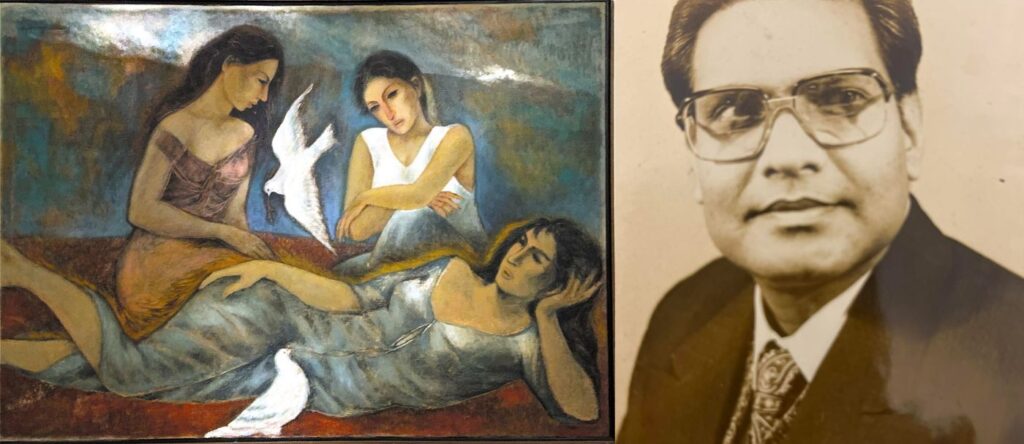
Biography
Dr. Anis Farooqi – A Legacy in Indian Modern Art
Dr. Anis Farooqi stands as a towering figure in the world of Indian modern art. As a painter, scholar, and art historian, his multifaceted contributions have left an enduring imprint on the cultural and intellectual fabric of India.
In 1989, Dr. Farooqi was awarded the prestigious National Award for Painting by the Lalit Kala Akademi, a testament to his artistic excellence. He served as the Director of the National Gallery of Modern Art (NGMA), New Delhi, for 13 years, until his untimely passing in 1994 while still in office. His tenure at NGMA is remembered for significantly expanding the gallery’s outreach and deepening its engagement with Indian modernism.
Personal Life
Dr. Anis Farooqi’s immediate family consists of his late wife, Nigar Farooqi, and two daughters, Dr. Zeba F Alam, and Yuman Hussain. His sons-in-law are Mr. Munawar Alam and Dr. M. Jawed (Member of Parliament, Kishanganj). His grandchildren include Miha Alam, Saruf Alam, Zarif Hussain, and Zahie Hussain.
Academic and Artistic Journey
Dr. Farooqi’s artistic foundation was laid at the prestigious Sir J.J. School of Art, Mumbai, from where he graduated with a diploma in Drawing and Painting in 1959. He went on to earn an M.A. in Drawing and Painting from Agra University (1962), followed by a Ph.D. in the History of Indian Art under the mentorship of the distinguished art historian Prof. Niharranjan Ray.
He joined the National Gallery of Modern Art (NGMA), New Delhi, in 1966, and after nearly two decades of service, became the second Director of NGMA in 1985, succeeding Dr. L.P. Sihare. He held the position until his passing in 1994.
Visionary Leadership at NGMA
Dr. Farooqi’s tenure at NGMA was marked by dynamic institutional reforms and cultural vision:
- Introduced rotational displays from NGMA’s permanent collection, moving away from static exhibitions.
- Initiated the regular showcasing of new acquisitions, ensuring a constantly evolving public engagement.
- Established a dedicated photographic wing, enhancing documentation and media visibility.
- Spearheaded the efforts to set up NGMA Mumbai and laid foundational work for NGMA Bangalore.
- Began the development of a new wing at NGMA Delhi, expanding the gallery’s infrastructure.
- Deepened international engagement and aligned NGMA’s practices with global museology standards.
Art Exhibitions and Major Showings
Dr. Farooqi’s work was showcased extensively in both national and international venues. Notable exhibitions include:
- Expressionist Tendencies in Indian and German Art, Max Mueller Bhavan – 1989
- Nature and Environment (New Delhi and Prague) – 1989
- National Exhibitions of Art, Lalit Kala Akademi – 1989, 1988, 1982, 1981, 1970, 1968, 1967, 1965
- Art Biennale, Dhaka – 1982
- Triennale Kala Mela – 1982
- The Changing Image, Lalit Kala Akademi – 1973
- AIFACS Annual Exhibitions – 1965, Ernakulam
- U.P. State Lalit Kala Akademi, Lucknow – 1966, 1963
- Indian Students Fair, Boston – 1963
Solo Exhibitions:
- New Delhi – 1982, 1966
Artist Camps & Travels:
- Participated in All India Artists Camp, Ganderbal, Kashmir – 1981
- Travelled to Japan, South Korea, China, USSR, Belgium, France, the U.K., Algeria, and the U.S.A.
Awards and Honors
Dr. Farooqi received numerous accolades for his contribution to art:
- National Award for Painting, Lalit Kala Akademi – 1989
- First Prize (Graphic & Drawing Section), Sahitya Kala Parishad – 1980–81
- Gold Medal, Inter-University Youth Festival, U.P. – 1961
- Silver Medal, All India Exhibition, Punjab – 1961
Collections
His works are part of prominent collections, including:
- National Gallery of Modern Art, New Delhi
- Lalit Kala Akademi, New Delhi
- Sahitya Kala Parishad, Delhi
- Punjab Government Museum & Punjab University Museum, Chandigarh
- British India Corporation, Kanpur
- Ghalib Academy, Doordarshan, and Institute of Medicine and Medical Research, New Delhi
Scholarship and Writing
In addition to being a visual artist, Dr. Farooqi was an erudite scholar. He authored:
- Art of India and Persia – 1979
- Hindostani Musavviri – Ek Khaka – 1981
He also wrote extensively in Indian research journals, reflecting a profound grasp of Indian art history, aesthetics, and cultural theory.
Institutional Affiliations and Committees
Dr. Farooqi held numerous advisory and executive roles, including:
- Member, Association of Art Historians of India
- Member, General Council and Executive Board, Lalit Kala Akademi
- Member, Triennale Committee, Lalit Kala Akademi
Legacy
Dr. Anis Farooqi’s life was a harmonious blend of creativity, scholarship, and leadership. His legacy lives on through his paintings, writings, institutional reforms, and the many artists and scholars he inspired. He remains a seminal figure in the story of post-independence Indian modernism — a name synonymous with intellectual depth and cultural vision in Indian art history.